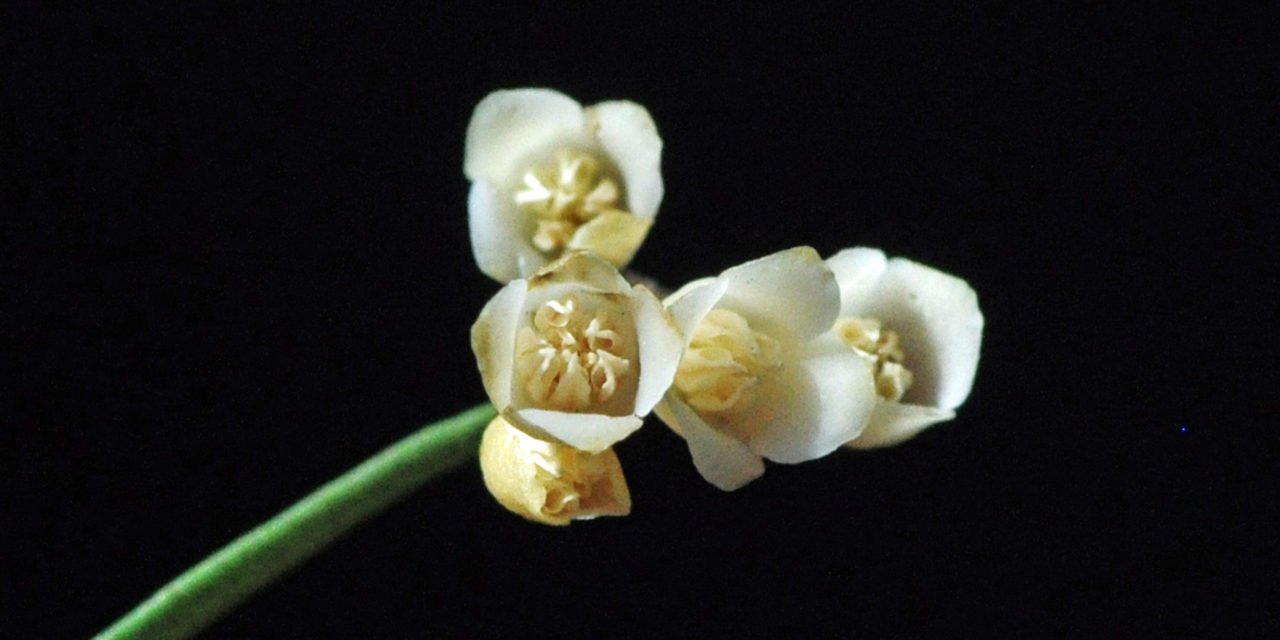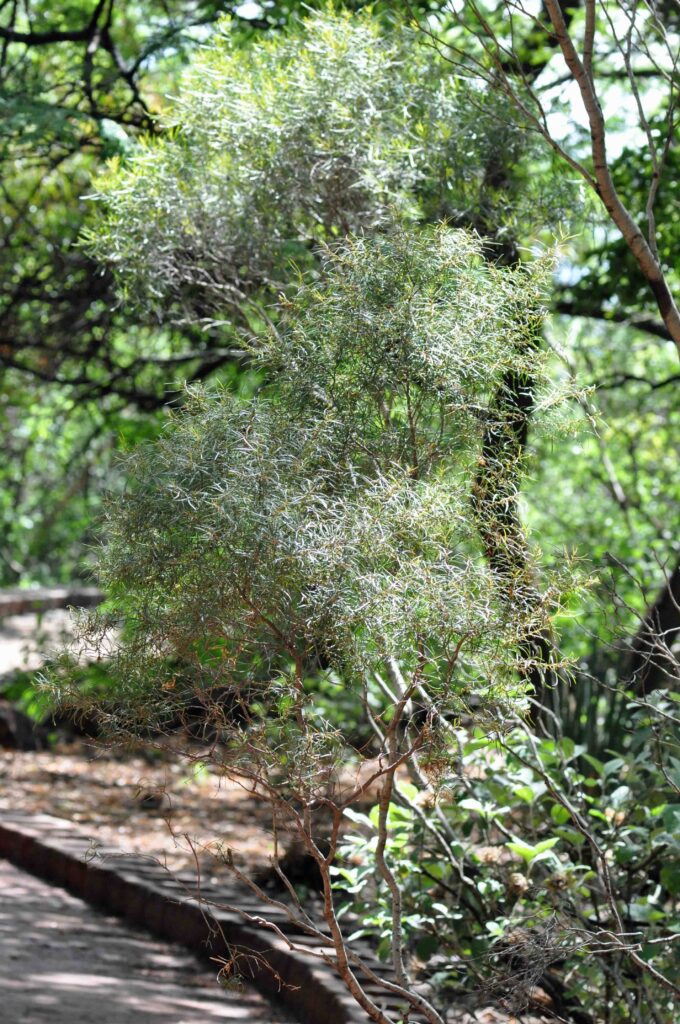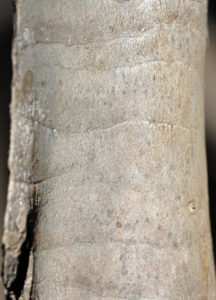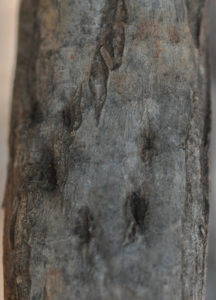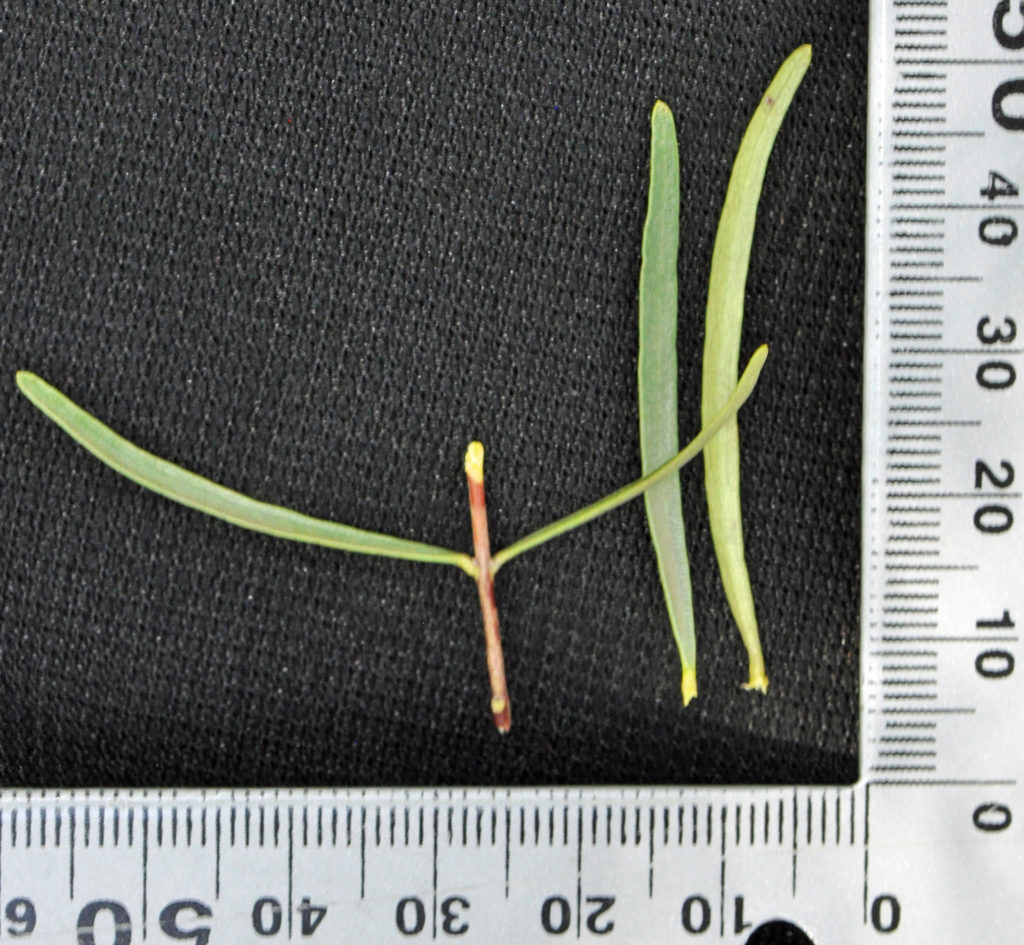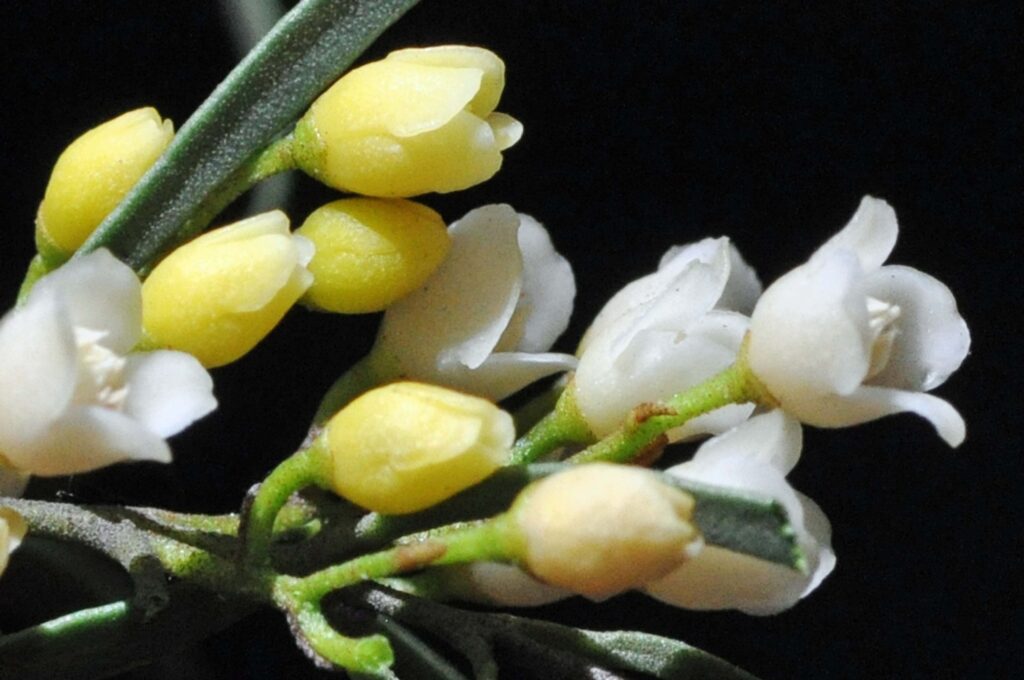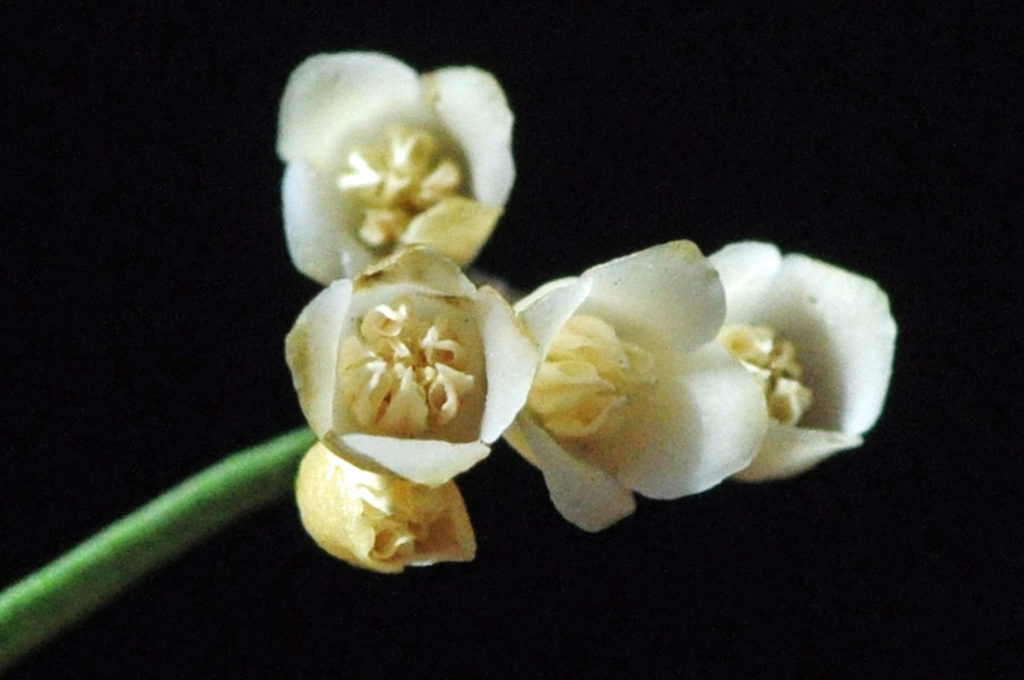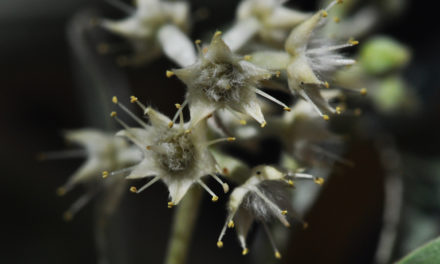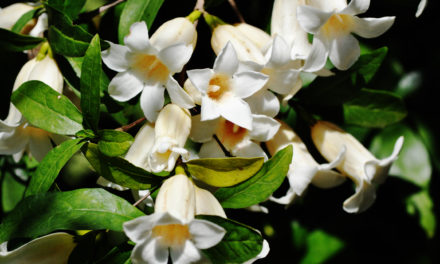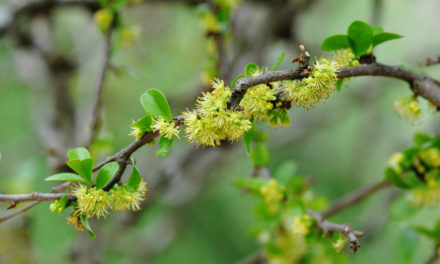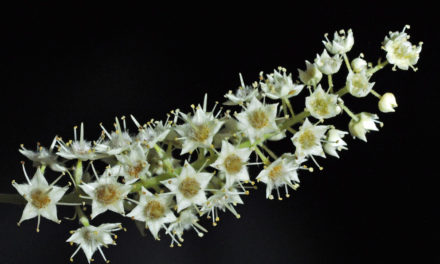General Info – summary
This evergreen dioecious shrub/Tree is up to 4m high. Olive-green, linear, usually opposite or nearly so Leaves are simple. The petiole is very short/absent. The white small, hairless, regular Flowers occur in racemes. Male flowers with anthers longer than the filaments. Female flowers have a single pistil with a superior ovary resting on a slightly fleshy disc. Thinly fleshy Fruit blackens and is a 1-seeded sweet berry.
Description
Euclea linearis
Previous Names: Euclea crispa subsp. linearis, Euclea eylesii.
SA Tree No. 596.
Common names: (Afr) Smalblaar, Smalblaarghwarrie. (Eng) Asbestos bush, Lance-leaved Guarri. (Tshivenda) Lutangule.
Family: Ebenaceae (persimmon and ebony family). The family has some plants known for the useful wood and others for fruit. There are more than 700 species, in 4 genera, worldwide – usually in tropical and warmer temperate regions. The 2 genera of Ebenaceae that occur in South Africa are Euclea and Diospyros. The simple, coriaceous and entire Leaves are usually alternate and lack stipules. The usually unisexual and regular Flowers have a persistent calyx that is often divided to near the base and the corolla usually has a short tube. The basifixed Anthers are longer than the Filaments. The superior Ovary has up to 2 ovules in each locule. The Styles may have 2-5 branches. Fruit is a berry, which may slowly dehisce. Young fruit contains tannins and may be avoided by animals.
Name derivation: Euclea – good fame: referring to the ebony like wood in some species. linearis linear – referring to the very narrow leaves.
Conservation: National Status: L C. (Least Concern). 2004 (J.E. Victor).
Tree
The Tree is a suffrutex (low-growing woody shrub or perennial with a woody base). It is often a much-branched shrub. However, trees about 1m high do occur (photo 489) and may reach 5m high. The light grey young Bark is smooth (photo 101). It becomes darker and slightly rough with age (photo 99). The slender, upward pointing Branches (photo 489 are light grey and generally narrow. Branchlets may be reddish brown. They are hard and may be slightly curved. No milky sap is present.
- 488. 2016/11/15. Pretoria NBG. Photo: David Becking..
- 101 2016.10.25 Pretoria NBG. Photo: David Becking.
- 99 2016.10.25 Pretoria NBG. Photo: David Becking.
Leaves
On this evergreen plant the very thin, hairless, olive green to yellowish green Leaves are simple (have a single blade which may have incisions that are not deep enough to divide the leaf into leaflets). Young leaves covered with yellowish granules. The mature hard leaves are up to 80 x 5mm, may be sickle-shaped and are linear (long, narrow leaf shape, with sides that are almost parallel with each other and usually are more than four times longer than broad). Leaves may are opposite (photo 92) or nearly so, or alternate. The Apex tapers abruptly and a hairline tip may be visible. The Base tapers and may be decurrent (here the leaf blade partly wrap or has wings around the petiole – leaf stalk). As a result, the Petiole is very short – about 1mm long or absent. The Margins are not wavy and are entire (with a continuous margin, not in any way indented). Veins are inconspicuous. Stipules (basal appendages of the petiole) are absent.
- 92 2016.10.25 Pretoria NBG. Photo: David Becking.
Flowers
Plants are dioecious (unisexual floral structures with male and female parts on separate plants). The small – up to 1,5cm long, creamy, hairless Flowers develop in leaf axils. They are in short Racemes (simple elongated inflorescences with stalked flowers that open in succession towards the apex – photo 104). Here the Pedicels (flower stalks) are distinct (photo 104). Flowers are actinomorphic (Regular, symmetrical. Flowers are vertically divisible into similar halves by more than 1 plane passing through the axis). Flowers are gamosepalous (a calyx whose sepals are partly united) at least at the base. The persistent Calyx is not accrescent (does not increasing in size with age after the corolla has fallen) and ends in 4 very short Sepals (photo 104). The initially yellow and Urceolate (with a swollen middle and narrowing top – urn shaped) Corolla with its overlapping Petal lobes are united at the base and are removable as a single piece – photo 104). The 4 open petals become an attractive white. In Male Flowers, the Stamens have Anthers, which dehisce through longitudinal slits and are longer than their Filaments (photo 95). In the Female Flowers, there is a single Pistil (a unit of the Gynoecium, the female element of the flower, composed of the Ovary, Style and Stigma) and the superior Ovary may have a single, pendulous Ovule in each locule. (Aug-Dec).
- 104. 2016/10/25. Pretoria NBG. Photo: David Becking.
- 95. 2016/10/25. Pretoria NBG. 2016.10.25. Photo: David Becking.
Fruit
The thinly fleshy mature Fruit is a black or purple Berry (pulpy, indehiscent fruit like a grape or tomato). Like the flowers these berries develop in short racemes and may have a few bristles attached. The fruit is up to 8mm in diameter and usually contains a single, usually globose Seed with curved grooves. (Feb-Jun).
Distribution & Ecology
This Plant is Endemic (restricted to a particular geographic location, such as an island, nation, country or other defined zone, or habitat type) in southern Africa (South Africa and Zimbabwe). These plants are located in the Northern Cape, Western Cape, Limpopo, Mpumalanga and Zimbabwe. This plant is a suffrutex (low-growing woody shrub or perennial with a woody base) and is located in several isolated and widespread areas. This plant is a suffrutex (low-growing woody shrub or perennial with a woody base) andis located in several isolated and widespread areas. It occurs in the districts of Calvinia in the Northern Cape, and Vanrhynsdorp – Western Cape (200km North of Cape Town – in the flower route) and Langekloof also in the Western Cape. Plants occur in scrub, dry bushveld, as well as grassy and rocky ridges and fynbos (a belt of natural shrubland or heathland in the winter rainfall area within the distinctive vegetation of the Western Cape). The next areas where the plants occur are in Gauteng and Mpumalanga. The Roots and Leaves have the ability to accumulate high levels of Iron and Aluminium. These plants can survive in heavy mineralized soils.
Ethnobotany
The ripe edible Fruit has purplish flesh that is sweet tasting. This Plant is used in local medicine e.g., parts mixed with snuff, make a brew with it, and used for chest complaints.
References
Boon, R. 2010. Pooley’s Trees of eastern South Africa. Flora and Fauna Publications Trust, Durban.
Coates Palgrave, M. 2002. Keith Coates Palgrave Trees of Southern Africa, edn 3. Struik, Cape Town.
Lawrence, G. H. M, 1951. Taxonomy of Vascular Plants, The Macmillan Company, New York. Tenth Printing 1965.
Palmer, E. & Pitman, N. 1972. Trees of southern Africa, Balkema, Amsterdam, Cape Town.
Schmidt, S. Lotter, M. & McCleland, W. 2002. Trees and Shrubs of Mpumalanga and the Kruger National Park.
van Wyk, B. & van Wyk, P. 1997 Field guide to Trees of Southern Africa, Struik, Cape Town.
Victor, J.E. 2004. Euclea linearis Zeyh. ex Hiern. National Assessment: Red List of South African Plants version 2020.1. Accessed on 2023/05/12.
http://repository.up.ac.za/bitstream/handle/2263/29756/07chapters11-12.pdf?sequence=8
http://posa.sanbi.org/flora/browse.php?src=SP

